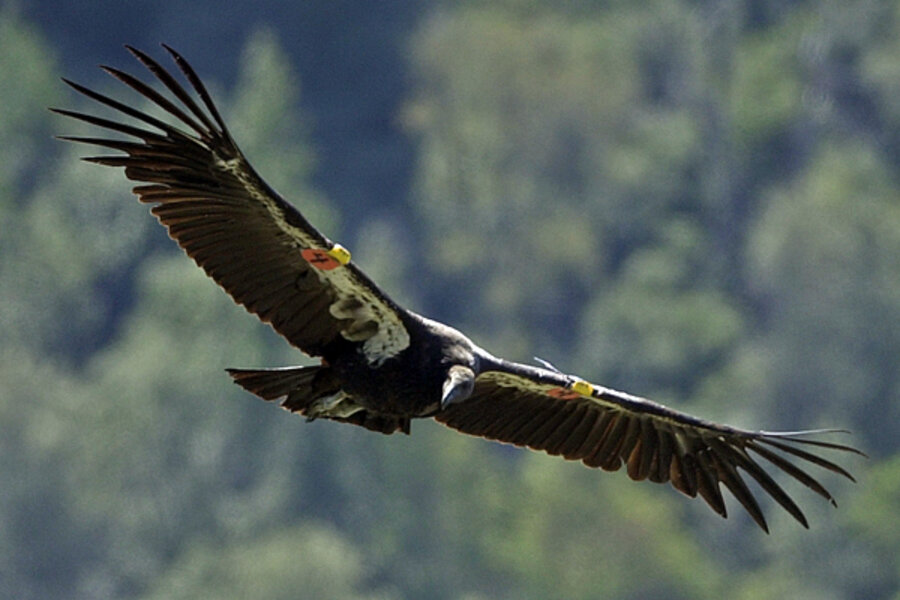Condors threatened by 'epidemic' lead poisoning from hunters' bullets
| SAN JOSE, Calif.
California condors, one of the world’s most endangered species, are poisoned by lead from hunters’ bullets “at epidemic levels,” and will not recover unless more is done to prevent it, a study released Monday concluded.
A review of more than 1,154 blood samples taken from wild California condors and tested from 1997 to 2010 found that 48 percent of the birds had lead levels so high, they could have died without treatment.
So far, a ban on lead bullets in the birds’ habitat appears to have had little effect, the study found.
“Lead poisoning is preventing the recovery of California condors,” said Myra Finkelstein, a research toxicologist at the University of California, Santa Cruz, who was a lead author of the study. “The population is not self-sustaining.”
Condors — the birds with the largest wingspan in North America — are scavengers. They eat dead deer, pigs and other animals, often that hunters have shot. They ingest bullet fragments and are poisoned.
California Gov. Arnold Schwarzenegger signed a law in 2007 to ban hunting with lead bullets, slugs or buckshot in the condors’ range, which extends from Los Angeles to San Jose, where the birds have been seen atop Mount Hamilton. But it hasn’t worked. Birds analyzed before the law took effect had blood levels the same as birds analyzed afterward.
The reason, said Finkelstein, is that a condor eat 75 to 150 dead animals a year.
“If just one has a lead bullet fragment, that can be enough to kill the bird,” she said.
Condors once ranged from British Columbia to Mexico. But because of habitat loss, hunting and lead poisoning, the population dwindled to just 22 nationwide by 1982.
Federal biologists captured all remaining wild condors in 1987 and began breeding them in zoos. The birds’ offspring have been gradually released back to the wild.
Today the California condor population has grown to 386. Of those, 213 live in the wild at Big Sur, Pinnacles National Monument in San Benito County, Southern California, Arizona, Utah and Mexico. The other 173condors live in captivity, at places such as the Los Angeles Zoo.
Although the population growth has been impressive, it is deceptive because it is highly dependent upon human intervention, the researchers said in Monday’s study, which was published in the Proceedings of the National Academy of Sciences.
Every free-flying condor has a radio or GPS collar to track it. Nearly all of them are captured twice a year and tested for lead. A few chicks have been born in the wild, but biologists still put out out food, such as stillborn calves, for the birds to eat so their population can have a chance to grow.
Monday’s study, which also looked at lead levels in condor feathers, confirmed that lead in the birds is coming from bullets, rather than other sources such as old paint chips, by matching isotope levels of lead in bullets tolead in the condors.
Researchers were surprised, Finkelstein said, by the extensive poisoning.
For example, 30 percent of all condors captured every year have lead levels that, while not potentially fatal, can block reproduction and cause immune system problems.
And 20 percent of the birds captured every year have levels that could kill them if not treated with chelation, a process where condors are fed calcium-based drugs that bind to the lead and help them pass it naturally. But the process also strips nutrients, and can cause the birds to be hospitalized a month or more.
In California, the state Department of Fish and Game and some hunting and environmental groups have worked to promote the lead ban in condor habitat. Some surveys show high compliance rates. But there is little enforcement, and ranchers or hunters can still use lead bullets and shot, which are cheaper and more readily available than other types of ammunition, such as copper, with little risk of getting caught.
Tthe Center for Biological Diversity, an environmental group based in Tucson, Ariz., and six other conservation groups sued the U.S. Environmental Protection Agency this month to force the agency to institute controls or bans on lead ammunition.
“We’ve removed toxic lead from gasoline, paint and most products exposing humans to lead poisoning, now it’s time to do the same for hunting ammunition to protect America’s wildlife,” said Jeff Miller, a spokesman for the Center for Biological Diversity.





